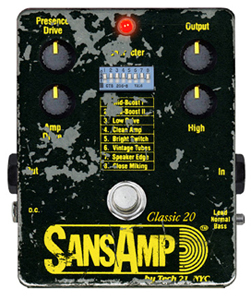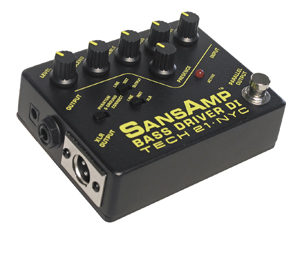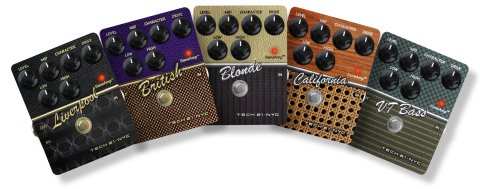Made In NY: Tech 21
It’s easy to forget how novel the concept of amp simulation was when Andrew Barta launched Tech 21.
In many ways, his inaugural SansAmp pedal was an unprecedented design. It was a stompbox that was more interested in helping players sculpt a tone than in delivering a discernible “effect.” And in an era when grunge guitarists, living blues legends, and over-the-top arena rockers still captured much of the nation’s imagination, it gained grassroots notoriety fast.
Although purists may still turn up their noses, while others use amp modelers on sources their creators never intended, this class of signal processor is now as much a part of modern recording as once-outrageous developments like the electric piano, the synthesizer, and the DAW.
Even detractors would find it hard to deny that modelers have helped changed the way we think about sounds. These devices were at the forefront of encouraging the post-modern approach to tinkering with tones that has since spilled over into recording technology, and gave new players an easy overview of classic sonic colors.
Tech 21 has been there since the beginning, and in an age where digital amp modelers have become ubiquitous, Barta has stuck to his original vision, developing new amp simulators using an entirely analog signal path. Dale Krevens, Tech 21’s Vice President and an integral part of the company’s success explains that at first, Barta had no plans to go into business for himself.
“Andrew took years developing this technology in his spare time, with the hope that [he’d] sell it to one of the major manufacturers.” The reception, she says, was the same everywhere: “Thanks, but no thanks.”
With persistent encouragement from the upbeat Krevens, Barta made the decision to begin building the SansAmp himself, selling the first units directly to players in 1989. “We didn’t know anything about manufacturing at first,” she says, but Barta learned as he went, finding new ways to shrink the size of the technology every step of the way, essentially building complete tube amp circuits in miniature, using FETs in place of valves.
Their first turning point would come at the 1991 winter NAMM show. “I’m not really a salesperson,” says Krevens, a woman who would go on to become something of a public face for the company. “I have to really believe in something to sell people on it. But with this it was easy – I got to see the reactions on people’s faces.”
According to her, NAMM visitors would invariably approach the booth in a skeptical mood – arms folded, poking around noncommittally, even suspiciously. Krevens, who delights in lightening people up, playfully mimics these early would-be critics in the huskiest voice she can muster: “They’d ask ‘So, what does it do?’. I’d tell them and they’d just go ‘Yeah, sure’.” But Dale, trim, bright-eyed and engaging even twenty years later, would easily convince conference-goers to stop and listen. “That’s when their jaws would drop. They’d just say ‘…What?’.
Like many fresh startups, they soon found word-of-mouth to be their greatest ally. “Dealers were just like the big manufacturers at first,” she laughs. “They didn’t get it.”
“It was players going into music shops and asking for these pedals that made the dealers finally start stocking them. They had to. [Many of them] ignored us at first, but after the ’91 NAMM show, they started calling us, asking “So, what’s a SansAmp?”. By 1992 they had to bring on new employees to keep up with the demand.
Dale was quick to join as full-time Vice-President soon after. “I was always in this world,” she says of the music industry. “I just didn’t know what my place was until [Tech 21 took off].”
Since their start, the company’s line has widened and deepened. When they discovered the SansAmp had become a surprise hit with bass players, Barta developed the dedicated Bass Driver DI, one of their most popular units to this day.
They’ve given the largest digital amp-modeling companies a run for their money over the years, building all-analog modeling amps that make up for their smaller market share with zealous devotion from their converted fans.
And, while Barta’s earliest pedal was a complex, intentionally over-designed swiss army knife of tone, more recent creations have delivered an alternative to this jigsaw approach to great guitar sounds: The Character Series features simple, intuitive pedals, each of which emulates the tone of a single classic series of amplifiers with a stomp of the foot.
While they’ve grown to become an internationally recognized name over the past two decades, it’s surprising to find Tech 21 still maintains a small team in the immediate metro area where they began. Matilde, the first employee hired to build pedals in the Manhattan workshop while Barta tinkered with new designs, still works for the company today.
In 2002, Tech 21 moved just across the river to Clifton NJ. “Manufacturing in Manhattan seems like a kind of wacky thing to do” says Krevens. “We would still be there if it wasn’t for the fact that we desperately needed a loading dock. They’re really hard to find in Manhattan.”
The company has a handful of long-time employees accustomed to a surprisingly breezy reverse-commute from Brooklyn, Manhattan, and Queens.
“We’d never move too far from New York,” Krevens says defiantly. “It’s where our roots are, and I’m not moving!”
Justin Colletti is a Brooklyn-based producer/engineer who works with uncommon artists, and a journalist who writes about music and how we make it. Visit him at http://www.justincolletti.com.










Robert L. Smith
July 14, 2011 at 6:26 pm (13 years ago)I still bring my Classic and Bass Driver pedals to every session!